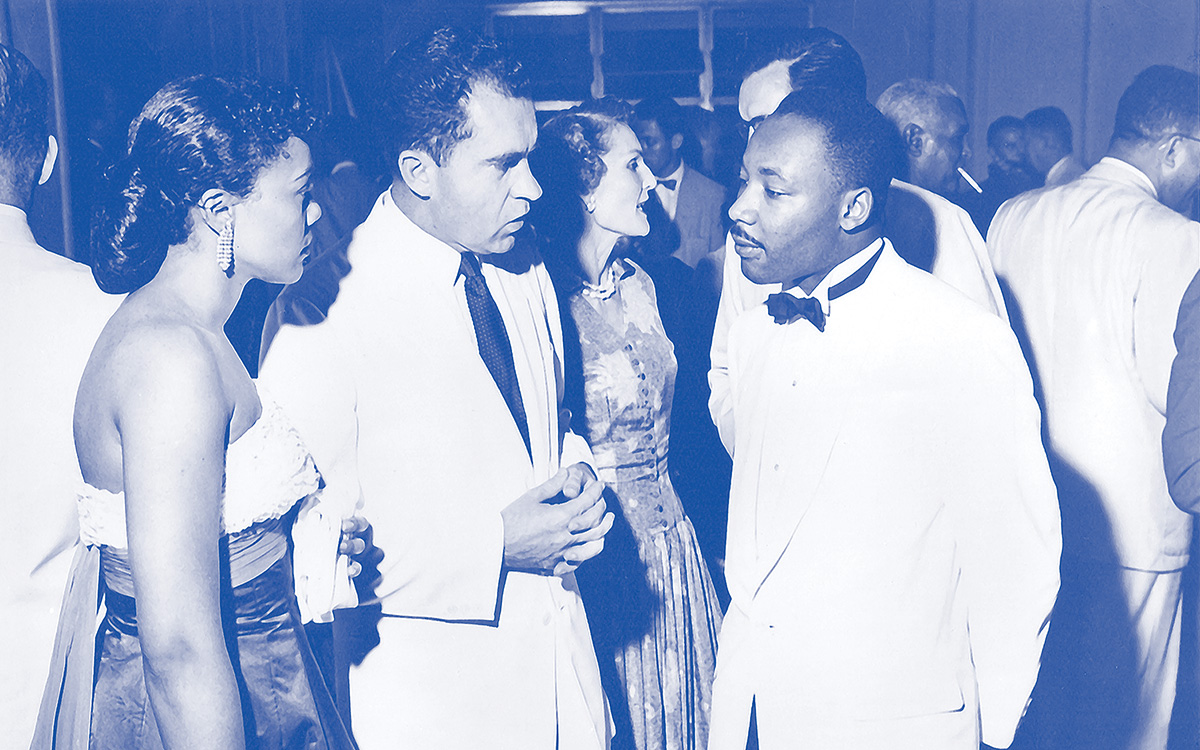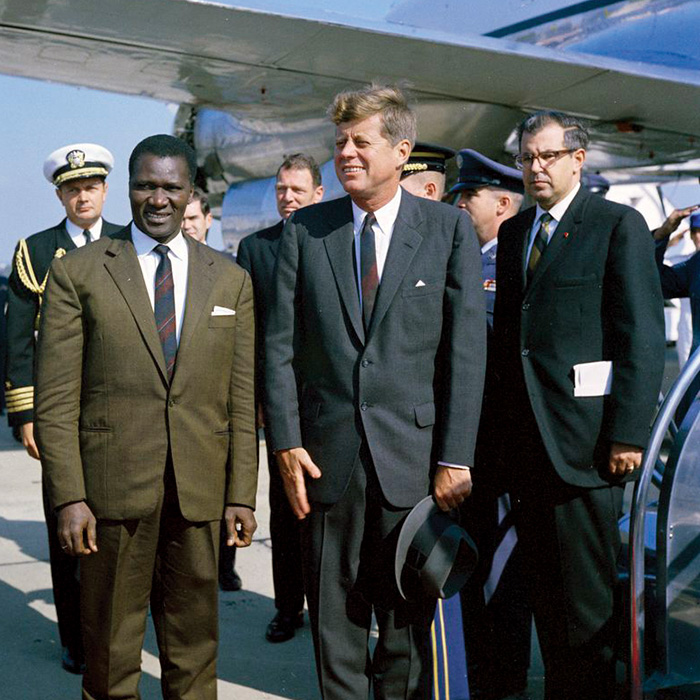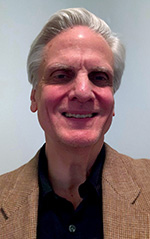Kennedy, Nixon and the Competition for Mr. Africa, 1952-1960
John F. Kennedy and Richard M. Nixon were the first American politicians of national rank to prioritize Africa—more than half a century ago.
BY GREGORY L. GARLAND
One of the more curious episodes in the history of American foreign relations was the competition for the unofficial title of Mr. Africa between two future presidents: Senator John F. Kennedy (D-Mass.) and Vice President Richard M. Nixon. These two ambitious men jumped at opportunities to associate themselves with the continent at a time when it attracted little interest from the Cold War–focused foreign affairs establishment.
Though their concerns were domestic, Kennedy and Nixon were the first American politicians of national rank to prioritize Africa. They drew widespread attention to Africa with compelling visions of positive engagement based on national interest.
In hindsight, these two young men and future presidents were modern-day policy pathfinders, pioneering the long, often convoluted, and still unfinished process of bringing the continent into the mainstream of American foreign policy and political debate.

Vice President Richard Nixon and Second Lady Patricia Nixon unexpectedly meet Rev. Martin Luther King Jr. and his wife, Coretta Scott King, for the first time during Independence ceremonies in Accra, Ghana, on March 7, 1957. Griffith “Griff” Davis, a pioneer photojournalist and African American Foreign Service officer with USAID from 1952 to 1985, took this famous shot.
An Atlanta boyhood friend of Martin Luther King Jr., Davis had been assigned by U.S. Information Service (USIS) in Washington, D.C., as the official photographer to cover Nixon’s inaugural visit to Africa, which was also King’s first visit, only months after the end of the Montgomery (Ala.) Bus Boycott and the launch of the civil rights movement in the U.S. The Kings had been invited by Ghana’s Prime Minister Kwame Nkrumah. The resulting photograph was not officially published in the U.S. at that time.
At the time of this assignment, Davis was finishing his first tour of duty as the first audiovisual adviser at U.S. Embassy Monrovia, the first U.S. embassy in a noncolonized African country. Davis’ daughter, Dorothy, president of Griffith J. Davis Photographs and Archives, recounts her father saying, “It was ironic to me that Montgomery, Alabama, and Washington, D.C., had to meet at Accra, outside the United States. However, it was only a short time later that M.L. and his nonviolent movement entered upon the national scene in America.” (This photo and story about Griffith Davis appeared in the opinion section and on the front page of the Tampa Bay Times, January 17 and 20, 2020, respectively.)
© Griff Davis / Griffith J. Davis Photographs and Archives
Domestic Calculations
Domestically, the two men competed for Black support. Republican Nixon especially needed those votes in industrial states that had trended Democratic. He had the political winds to his back. The 1954 Brown v. Board of Education of Topeka decision, led by Nixon’s fellow California Republican Chief Justice Earl Warren, invigorated a pro–civil rights image for the GOP, reinforced by President Dwight Eisenhower’s forceful response to the Little Rock integration crisis in 1957. Nixon successfully cultivated support from Black celebrities, notably baseball’s Jackie Robinson, another Californian.
Indeed, Nixon could take justifiable pride in his civil rights record. Honorary member of the National Association for the Advancement of Colored People for his service in Congress, he was the first prominent member of the Eisenhower administration to endorse publicly the Brown decision. He also backed the Civil Rights Act of 1957. In 1960, he worked with New York Governor Nelson Rockefeller to include a strong civil rights plank in the Republican platform. Accordingly, he shared the liberal racial views of many of his party’s stalwarts, including recent nominees Thomas Dewey and Wendell Willkie.
Still, Nixon needed to bolster his foreign policy bona fides, as well as win Black support. Seeing Africa as the answer to both, he became the GOP’s go-to Africanist, representing the United States at the widely publicized independence ceremonies of Ghana in 1957. There, Nixon unexpectedly met the Reverend Martin Luther King Jr., fresh off his leadership of the Montgomery, Alabama, bus boycott. The photograph of their encounter appeared in Black media throughout the U.S., sending the message that Nixon had his ear to the rising civil rights movement as well as to Africa.
Meanwhile, Kennedy calculated similarly. The precarious New Deal coalition of pro–civil rights Northerners and a segregationist Southern base suggested a formula that might achieve just enough to win: avoid civil rights and talk about Africa. The balancing act was realpolitik for Democrats. In 1952, despite Adlai Stevenson’s winning 79 percent of Black votes nationally, Eisenhower swept the North and carried several Southern states. Stevenson’s numbers fell to 61 percent in 1956, and Rev. King and Rep. Adam Clayton Powell (D-N.Y.) announced their votes for Eisenhower. Democrats thus could no longer take either Black Northerners or white Southerners for granted, yet still needed both to win.
Kennedy would spell out his approach to Africa on July 2, 1957, in his first major foreign policy address, later known as the Algeria speech. “The most powerful single force in the world today is … man’s eternal desire to be free and independent,” he said. “The great enemy of that tremendous force of freedom is called, for want of a more precise term, imperialism.” In recognizing that the imminent process of decolonization would profoundly alter the geopolitical landscape, he distinguished himself from the older generation of politicians and their Eurocentric bipartisan foreign policy consensus.
Though both Nixon and Kennedy asserted that the Cold War would be fought and won in the so-called Third World, Kennedy defined winning differently. He asserted that nationalism was more strategically important than communism and insisted that America back the nationalists, even against Washington’s European allies. African independence leaders such as Sékou Touré, Tom Mboya and Kwame Nkrumah saw him as a unique U.S. politician who grasped their interests and voiced them in a way that Americans could understand.
Ordinary Americans were also starting to notice the continent. A 1950 remake of King Solomon’s Mines struck gold at the box office. John Ford’s “Mogambo” (1953) with Clark Gable, Ava Gardner and Grace Kelly, and John Huston’s “The African Queen” (1951) with Humphrey Bogart and Katharine Hepburn, were magnificently filmed on location. If such icons as Gable and Bogart could reinvent themselves in the heart of Africa, maybe the Dark Continent beheld a new frontier after all. In 1955, John Gunther’s thousand-page Inside Africa was a bestseller.
Guinea: Ground Zero of Africa Policy
Richard Nixon’s Africanist bona fides rested primarily on his March 1957 trip to Accra as Washington’s representative at Ghana’s independence celebrations. His widely publicized trip report recommended that a new Bureau of African Affairs be established at State, embassies be set up in every country and substantial economic development assistance extended. Regardless, Nixon eyed Kennedy warily. As the latter hammered the vice president’s failure in his report to mention Algeria, he provoked doubts about Nixon’s judgment and ability to overcome Cold War–driven policy deference to France. Believing Kennedy was wrong on Algeria and simply trying to upstage his own ownership of the Africa issue, Nixon drove the Eisenhower administration’s damage control in the speech’s aftermath.
Attention soon shifted to another rebellious French colony. In September 1958, Guinea rejected French President Charles de Gaulle’s plan to grant its African colonies independence but remain tied to France economically. Furious, de Gaulle directed departing French officials to leave nothing of value behind, a punitive action that poisoned the Franco-Guinean relationship for decades to come. Sékou Touré thus took over a country economically shattered by de Gaulle’s wrath. While the Soviet Union jumped at the opportunity to befriend Guinea, Washington waffled, struggling to balance support for African independence with its alliance with France. No embassy opened for another eight months, and plans for an aid package stalled.
Kennedy staffed the Africa Bureau early on with strong, politically attuned leadership [and] chose highly visible ambassadors to Africa.
Touré begged Eisenhower for more, insisting that neutrality was his objective. As evidence of his sincerity, he offered to visit the United States, which Washington accepted. The state visit, which occurred from Oct. 25 through Nov. 9, 1959, was the baptismal program of the new Bureau of African Affairs, which, with Nixon pushing hard, had opened its doors on Sept. 8. It also marked Touré’s first official travel beyond Africa as head of state; thus, its success meant as much to the new bureau as to the leader of the new country. Moreover, it elevated Nixon’s policy leadership.
Ambassador to Guinea John Morrow recommended extended orientation travel around the United States. Touré himself wanted to see the South. Atlanta, Touré’s preferred choice, was dropped because of fear of a racially motivated slight by the governor of Georgia. Consequently, Governor Luther Hodges of North Carolina, Morrow’s home state, came to the rescue. Touré received an honorary degree from Morrow’s recent employer, North Carolina College, then lunched with the president of crosstown (and segregated) Duke University. He stayed the night in the venerable Carolina Inn in Chapel Hill as its first Black guest.
After a stop in Chicago, Touré flew to Nixon’s Southern California, but curiously without Nixon. Instead, Kennedy seized the moment to helicopter dramatically into Disneyland to meet the Guinean. The visit climaxed in New York City with a tickertape parade and an exhibition of Guinean works at the New York Museum of Primitive Art, hosted by French-speaking Governor Nelson Rockefeller.
Advantage Kennedy
For the Guineans, Kennedy’s performance was the high point; Touré would follow the presidential campaigns of the next two years closely. In stark contrast to Kennedy, Eisenhower’s perceived ambivalence and sluggishness left the Africans cold. The nonverbal message communicated to Africans at the presidential level was that Africa still did not much matter. Moreover, the Republican who most impressed the Guineans was neither Eisenhower nor Nixon, but Rockefeller, considered the vice president’s main rival for the nomination.
A sluggish image afflicted the final two years of the Eisenhower administration. The president himself suffered two heart attacks that sapped his energy and contributed to the image of an out-of-touch old man. Secretary of State John Foster Dulles’ fatal illness during the second term deprived foreign policy of its prime advocate. Nowhere was this truer than in its approaches to Africa. Slow to respond and unable to anticipate the consequences of decolonization, the U.S. deferred to the Europeans. Nixon’s African efforts thus hit a wall, leaving the field open to Kennedy.
Although Kennedy took over the new subcommittee on Africa in 1959, he ended up chairing only one session as he focused on his presidential campaign. Nixon’s repeated criticism that Kennedy was an absentee chair was on point, although the implication that the senator postured on Africa for only political purposes missed the mark. Regardless, Africans heard little of the criticism. On the contrary, in August 1960, the news that Africa Subcommittee Chairman Kennedy was sending former New York Governor and Ambassador to the Soviet Union Averell Harriman on a fact-finding trip to Guinea and several other African countries only stoked their enthusiasm for the senator.
Africa continued to make headlines. Under pressure from the United Nations, the Belgians fast-forwarded Congolese independence to July 1960. Things went wrong from the beginning, however, and the pall of the Congo hung over the presidential campaign. Kennedy constantly invoked Africa on the hustings, delivering 13 formal speeches on the topic and referring to it 479 times. Kennedy’s choice of Harris Wofford as speechwriter confirmed the close link on his own staff between domestic civil rights and Africa. Wofford had served as an attorney for the U.S. Civil Rights Commission and in 1959 edited its first report to Congress. His selection made plain that the intended audience was Black Americans.
The Mboya Initiative
Not long before their respective nominations in the summer of 1960, Nixon and Kennedy confronted each other again over Africa. Kenyan trade union leader Tom Mboya approached a small group of private Americans about organizing a program for several hundred compatriots to study in American universities to prepare a cadre of qualified personnel to lead their country into independence. Celebrities Jackie Robinson, Harry Belafonte and Sidney Poitier donated their time and names to the project. The missing piece was transportation to the U.S.
Robinson lobbied Nixon personally, and Nixon, in turn, pressed State to produce assistance. Rather than go through Nixon, Assistant Secretary of State for African Affairs Joseph Charles Satterthwaite wrote Robinson directly on July 11 to reject a State role, claiming that he had heard nothing from the Department of Defense to follow up on Nixon’s ideas. Moreover, the Bureau of Educational and Cultural Affairs objected to funding Mboya in any form; it wanted State to work with one of its officially designated organizations for student programs, the Institute for International Education or the Africa-America Institute (which operated at a much higher overhead and longer planning timelines and could not have approached anywhere near the 800 students Mboya finally sent to America).
Frustrated with Nixon, several influential activists approached Wofford, Kennedy presidential campaign press spokesman Pierre Salinger and Kennedy brother-in-law Sargent Shriver (who ran the family’s Joseph P. Kennedy Jr. Foundation). Succeeding in getting an invitation to meet the candidate, on July 26, 1960, Mboya flew to the Kennedy family compound at Hyannis Port, Massachusetts. Wofford later wrote: “Seeing the easy rapport of these two young men, each heading for the top leadership of his nation, I had a sense that day of the far-reaching changes to come in the relationship between America and Africa.”
Subsequently, Shriver told the Mboya supporters that the foundation would contribute $100,000 to the airlift and an additional $100,000 to defray expenses of the students in the U.S. There was just one condition: no publicity, although word of his family’s role finally surfaced shortly.
The Debates

On Oct. 10, 1962, President John F. Kennedy received President of Guinea Ahmed Sékou Touré at Washington National Airport for a state visit. African independence leaders saw Kennedy as a unique U.S. politician who grasped their interests. From left: Naval Aide to President Kennedy, Captain Tazewell T. Shepard Jr.; President Touré; U.S. Assistant Chief of Protocol for Visits and Public Events Samuel L. King (in back); President Kennedy; and U.S. State Department interpreter José de Seabra.
JFK Presidential Library and Museum
There is no better measure of the weight of Africa on the 1960 campaign than the televised debates. Kennedy opened with the Africa card, putting Nixon on the defensive in the foreign policy arena in which he was most comfortable, in the process turning to a GOP icon, Abraham Lincoln.
“In the election of 1860, Abraham Lincoln said the question was whether this nation could exist half-slave or half-free,” Kennedy intoned. “In the election of 1960, and with the world around us, the question is whether the world will exist half-slave or half-free, whether it will move in the direction of freedom, in the direction of the road that we are taking, or whether it will move in the direction of slavery. I want people in Latin America and Africa and Asia to start to look at America; to see how we’re doing things; to wonder what the president of the United States is doing; and not to look at Khrushchev or look at the Chinese Communists.”
Kennedy did not return to Africa until the fourth and final debate, when he echoed the language of his Algeria speech: “Africa is now the emerging area of the world. It contains 25 percent of all the members of the [United Nations] General Assembly. We didn’t even have a Bureau of African Affairs until 1957 [sic, 1958]. In the Africa south of the Sahara, which is the major new section, we have less students from all of Africa in that area studying under government auspices today than from the country of Thailand. If there’s one thing Africa needs, it’s technical assistance.”
Yet in 1959, Kennedy went on to note, less than 5 percent of all U.S. technical assistance went to Africa. Six African countries are members of the United Nations, he said, but there wasn’t a single American diplomatic representative in any of them. And when Guinea became independent, he added, the Soviet ambassador showed up that same day, but it took nearly eight months for the U.S. ambassador to appear.
Such was the impact of Kennedy’s words that three days later, Assistant Secretary Satterthwaite convoked a lengthy briefing to defend the administration’s Africa policy.
Mr. Africa: A Mixed Record
Kennedy won the unofficial title of Mr. Africa, which helped to fuel his narrow electoral victory. Africa thus served successfully as an indirect and noncontroversial means to reach Black voters while skirting the explosive language of civil rights. It was just enough to win key industrial states without losing the Deep South, a masterful political juggling act. Nixon read the election returns, too, and would later switch gears to implement a Southern Strategy that would capture the White House in 1968.
Kennedy’s victory raised hopes for a new day in U.S.-African relations. He staffed the Africa Bureau early on with strong, politically attuned leadership, starting with Michigan Governor G. Mennen Williams as assistant secretary. He chose highly visible ambassadors to Africa, including his prep school classmate, magazine editor and fluent French speaker William Attwood to Guinea. He launched the Peace Corps and put brother-in-law Shriver in charge. He reached out to independence movements, notably Mozambique’s Eduardo Mondlane, a product of American education who was married to an American and who had a base of support in the liberal churches and foundations.
Yet Kennedy’s presidential record in Africa would prove mixed, at best. Days after his inauguration, he faced a crisis in the former Belgian Congo and charges of CIA involvement in the assassination of the country’s first prime minister, Patrice Lumumba. His support for Mondlane prompted threats by Portuguese dictator and NATO ally Antonio Salazar to terminate the Azores base agreement. Kennedy then backed off from Mondlane, a message that pushed Africans to look elsewhere for support. Finally, Kennedy’s assassination in 1963 abruptly ended what remained of his Africa outreach. Successor Lyndon B. Johnson practiced a hands-off approach in Africa whose primary criteria for U.S. support was opposition to communist influence, a hardline attitude that isolated Guinea’s Sékou Touré and contributed to his increasingly harsh rule.
To be sure, Kennedy’s vision resonated among those Americans most interested in the continent of Africa, but it would take another generation to build sufficient grassroots political force to influence policy. The anti-apartheid movement eventually enjoyed success in pressuring Congress and a reluctant Ronald Reagan White House to impose sanctions in 1985 on white-ruled South Africa and support negotiations to bring independence to Namibia and end civil wars in Mozambique and Angola.
Read More...
- “‘Campaign of the Century’ Review: Revisiting Kennedy vs. Nixon” by Robert W. Merry, The Wall Street Journal, February 2022
- “The African Airlift” by Karen Rothmyer, The Nation, September 2009
- “Black Voters, Africa, and the 1960 Presidential Campaign” by JH Merriwether, The Office of American Historians, 2008
- “Human Rights and American Foreign Policy in Africa” by Armistead Lee, The Foreign Service Journal, October 1978





